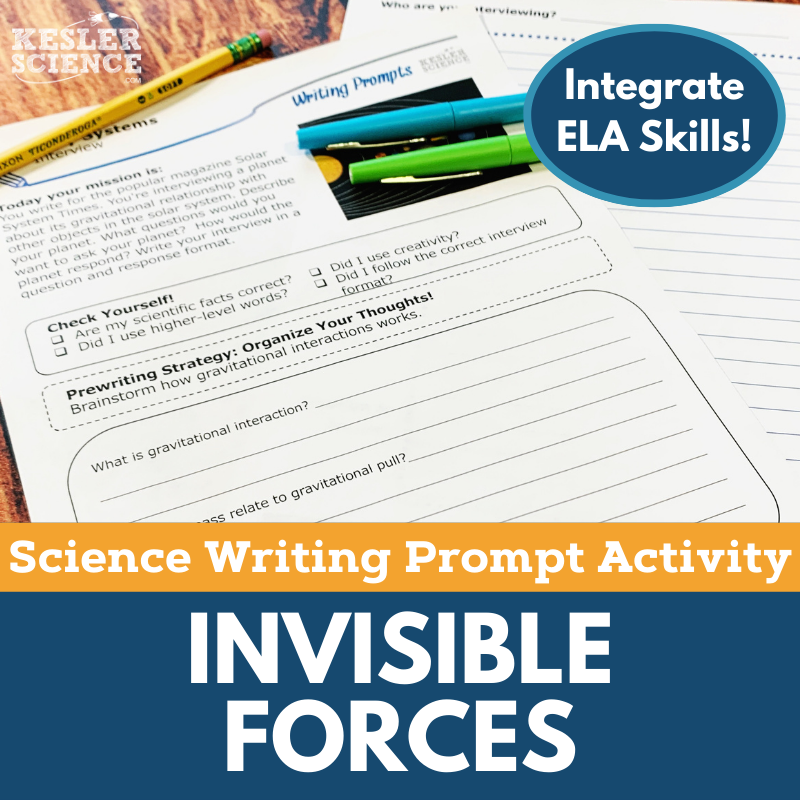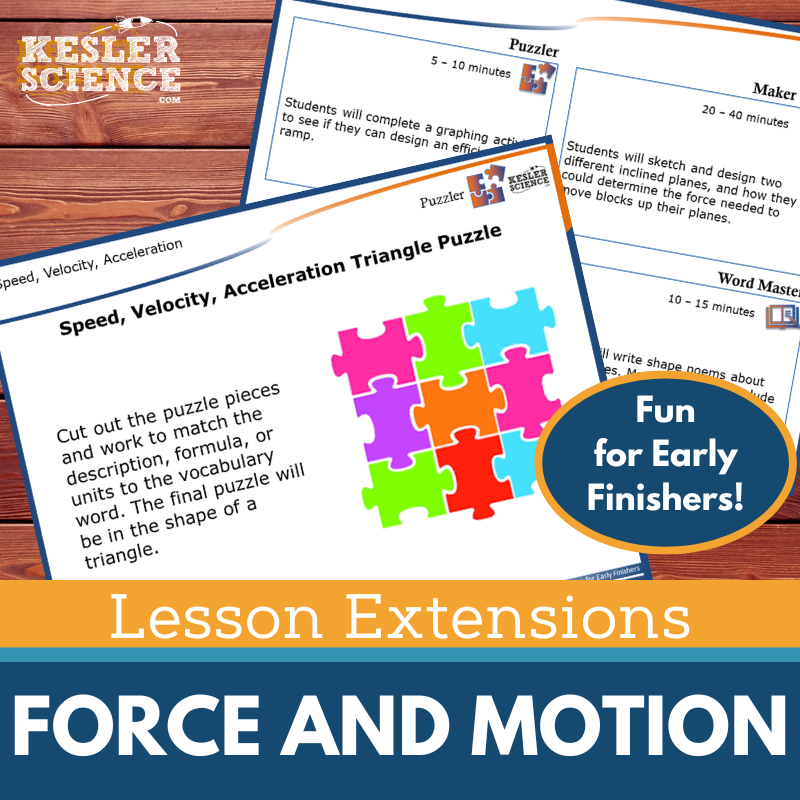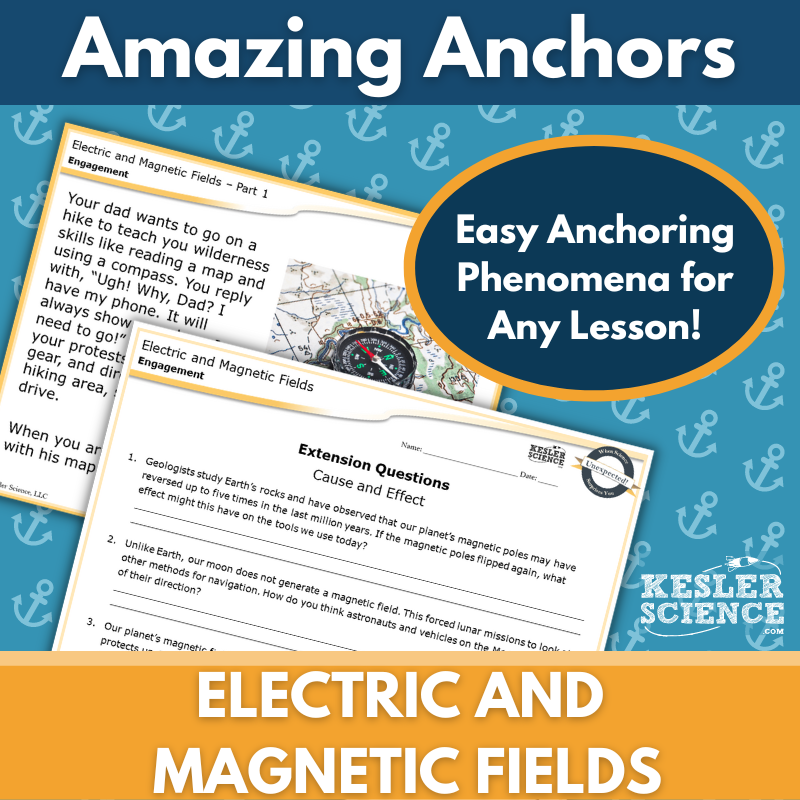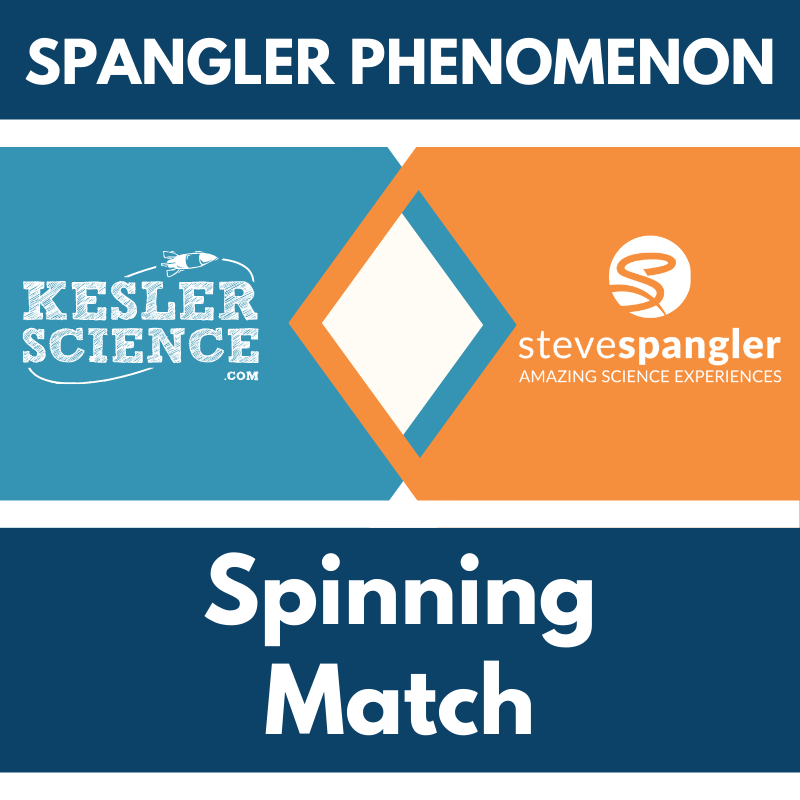Noncontact Forces Activities for Middle School Science
Aligned with NGSS MS-PS2-5, these engaging lessons help students explore the effects of energy and distance on electrical forces through hands-on and digital investigations. The resources below will give students a comprehensive understanding of noncontact forces. All of the following materials are also included in the Kesler Science Membership.
The Noncontact Forces Inquiry Lab aligns with NGSS MS-PS2-5, guiding students to investigate how energy and distance influence electrical forces between objects. Students build a charge detector and use it to explore interactions between charged objects, reinforcing the concept that forces exist even when objects are not in contact.
This lab offers both hands-on and digital versions, allowing flexibility for in-person and virtual learning. The digital format includes an interactive PowerPoint compatible with Google Slides, featuring embedded activities and a video demonstration of the lab procedure. The print format provides a structured, hands-on experiment where students record observations and conclusions.
Three differentiated versions—Dependent, Modified, and Independent—cater to varying student needs, ranging from guided inquiry to self-directed exploration. The resource includes comprehension questions, Claim-Evidence-Reasoning (C.E.R.) prompts, reflection sections, teacher resource pages, answer keys, and editable materials to support diverse classrooms.
The Noncontact Forces Inquiry Lab aligns with NGSS MS-PS2-5, guiding students to investigate how energy and distance influence electrical forces between objects. Students build a charge detector and use it to explore interactions between charged objects, reinforcing the concept that forces exist even when objects are not in contact.
This lab offers both hands-on and digital versions, allowing flexibility for in-person and virtual learning. The digital format includes an interactive PowerPoint compatible with Google Slides, featuring embedded activities and a video demonstration of the lab procedure. The print format provides a structured, hands-on experiment where students record observations and conclusions.
Three differentiated versions—Dependent, Modified, and Independent—cater to varying student needs, ranging from guided inquiry to self-directed exploration. The resource includes comprehension questions, Claim-Evidence-Reasoning (C.E.R.) prompts, reflection sections, teacher resource pages, answer keys, and editable materials to support diverse classrooms.
This Force Fields Science Reading Comprehension Lesson helps students explore how objects exert forces on each other without direct contact. Designed for middle school, the leveled passage supports science literacy and reading comprehension.
Students read a nonfiction article about force fields, answer five to seven comprehension questions, and design an experiment demonstrating magnetic fields in action. A hands-on, interactive mini-project reinforces key concepts, and a Cornell notes template is included.
Ideal for sub plans, extra credit, ISS, or whole-class instruction, this resource fosters critical thinking, classroom discussions, and textual analysis. It is compatible with virtual learning platforms like Google Classroom, MS Teams, Schoology, and Canvas.
This Force Fields Science Reading Comprehension Lesson helps students explore how objects exert forces on each other without direct contact. Designed for middle school, the leveled passage supports science literacy and reading comprehension.
Students read a nonfiction article about force fields, answer five to seven comprehension questions, and design an experiment demonstrating magnetic fields in action. A hands-on, interactive mini-project reinforces key concepts, and a Cornell notes template is included.
Ideal for sub plans, extra credit, ISS, or whole-class instruction, this resource fosters critical thinking, classroom discussions, and textual analysis. It is compatible with virtual learning platforms like Google Classroom, MS Teams, Schoology, and Canvas.
The Invisible Forces Science Writing Prompt Activity engages middle school students in a creative narrative exercise to reinforce their understanding of physical science. Aligned with NGSS MS-PS2-5, this low-prep, student-centered activity challenges students to investigate and evaluate experimental designs, providing evidence of fields existing between objects that exert forces without contact. Designed for both in-person and virtual learning, this activity supports science reasoning and exploration while enhancing writing skills.
This resource includes teacher directions with answer guides and rubrics, projection and print handouts, and a digital PowerPoint version compatible with Google Slides. Full-sized and half-sheet handouts offer flexible use, making it easy to integrate into interactive notebooks or writing journals. Ideal as a cross-curricular activity, pre-test assessment, student choice project, or enrichment for early finishers, this writing prompt also works well for extra credit, make-up work, TELPAS samples, and differentiation. Perfect for classroom display or student anthologies, this engaging activity ensures students apply their prior knowledge in a meaningful way.
The Invisible Forces Science Writing Prompt Activity engages middle school students in a creative narrative exercise to reinforce their understanding of physical science. Aligned with NGSS MS-PS2-5, this low-prep, student-centered activity challenges students to investigate and evaluate experimental designs, providing evidence of fields existing between objects that exert forces without contact. Designed for both in-person and virtual learning, this activity supports science reasoning and exploration while enhancing writing skills.
This resource includes teacher directions with answer guides and rubrics, projection and print handouts, and a digital PowerPoint version compatible with Google Slides. Full-sized and half-sheet handouts offer flexible use, making it easy to integrate into interactive notebooks or writing journals. Ideal as a cross-curricular activity, pre-test assessment, student choice project, or enrichment for early finishers, this writing prompt also works well for extra credit, make-up work, TELPAS samples, and differentiation. Perfect for classroom display or student anthologies, this engaging activity ensures students apply their prior knowledge in a meaningful way.
The WIKI Tickets© Force and Motion Set provides engaging, flexible formative assessments for 6th-8th grade science. This set includes 14 topics, each with five format options: a full-screen projection version, three print handouts, and an interactive digital version compatible with PowerPoint and Google Slides.
Aligned with NGSS and TEKS standards, these assessments cover key concepts such as calculating speed and unbalanced forces, graphing motion, Newton’s laws, gravity and mass, inclined planes, invisible forces, and velocity and acceleration. A table of contents file is included to show alignment with standards.
Designed for both in-person and virtual learning, WIKI Tickets© can be used as exit tickets, bellringers, or quick checks. Students can write responses on paper, complete printed versions, or interact with the digital files in a 1:1 or remote setting. These colorful, engaging assessments help you gauge student understanding with ease.
The WIKI Tickets© Force and Motion Set provides engaging, flexible formative assessments for 6th-8th grade science. This set includes 14 topics, each with five format options: a full-screen projection version, three print handouts, and an interactive digital version compatible with PowerPoint and Google Slides.
Aligned with NGSS and TEKS standards, these assessments cover key concepts such as calculating speed and unbalanced forces, graphing motion, Newton’s laws, gravity and mass, inclined planes, invisible forces, and velocity and acceleration. A table of contents file is included to show alignment with standards.
Designed for both in-person and virtual learning, WIKI Tickets© can be used as exit tickets, bellringers, or quick checks. Students can write responses on paper, complete printed versions, or interact with the digital files in a 1:1 or remote setting. These colorful, engaging assessments help you gauge student understanding with ease.
Lesson Extensions provide engaging, student-choice activities designed to challenge early finishers and deepen their understanding of force and motion standards. These activities help reinforce critical thinking, fill downtime, and keep students engaged with rigorous yet enjoyable learning opportunities. Aligned to NGSS and TEKS, they offer high-level enrichment that encourages deeper exploration of key physics concepts.
Each extension includes four interactive components: Puzzler for problem-solving, Maker Space for hands-on STEAM activities, Tech Connection for digital demonstrations, and Word Master for creative writing. With teacher directions, answer keys, and both print and projection versions, these extensions are perfect for lesson wrap-ups, enrichment, or independent challenges.
Covering topics such as Newton’s laws, motion and forces, gravity, speed, velocity, acceleration, and electromagnetic forces, these extensions ensure students remain engaged while strengthening their understanding of fundamental physics concepts.
Lesson Extensions provide engaging, student-choice activities designed to challenge early finishers and deepen their understanding of force and motion standards. These activities help reinforce critical thinking, fill downtime, and keep students engaged with rigorous yet enjoyable learning opportunities. Aligned to NGSS and TEKS, they offer high-level enrichment that encourages deeper exploration of key physics concepts.
Each extension includes four interactive components: Puzzler for problem-solving, Maker Space for hands-on STEAM activities, Tech Connection for digital demonstrations, and Word Master for creative writing. With teacher directions, answer keys, and both print and projection versions, these extensions are perfect for lesson wrap-ups, enrichment, or independent challenges.
Covering topics such as Newton’s laws, motion and forces, gravity, speed, velocity, acceleration, and electromagnetic forces, these extensions ensure students remain engaged while strengthening their understanding of fundamental physics concepts.
This Amazing Anchors Phenomenon Lesson introduces and reinforces electric and magnetic fields through real-world connections. It begins with an introductory reading on how a compass works, accompanied by comprehension and extension questions to prepare students for further learning. An explanatory reading breaks down the science behind the forces that move a compass in an understandable way, with additional questions to reinforce comprehension.
Aligned with NGSS PS2-5, this no-prep resource includes teacher directions with answer keys, projection slides, and both print and digital formats for flexible use in any classroom. A modified version with differentiated language and sentence starters supports student comprehension. Designed to bookend a lesson, these engaging readings serve as valuable supplements for the Engagement and Elaborate segments of 5E lessons in both in-person and virtual settings.
This Amazing Anchors Phenomenon Lesson introduces and reinforces electric and magnetic fields through real-world connections. It begins with an introductory reading on how a compass works, accompanied by comprehension and extension questions to prepare students for further learning. An explanatory reading breaks down the science behind the forces that move a compass in an understandable way, with additional questions to reinforce comprehension.
Aligned with NGSS PS2-5, this no-prep resource includes teacher directions with answer keys, projection slides, and both print and digital formats for flexible use in any classroom. A modified version with differentiated language and sentence starters supports student comprehension. Designed to bookend a lesson, these engaging readings serve as valuable supplements for the Engagement and Elaborate segments of 5E lessons in both in-person and virtual settings.
This Spangler Phenomenon lesson on fields and exerting force features an exclusive Steve Spangler video designed to captivate students and enhance their analytical skills. The interactive investigation centers around the question: When static electricity causes an object to move without being touched, what is the cause, and what is the effect?
Aligned with the NGSS MS-PS2-5 standard, this lesson follows the 5E framework and incorporates three-dimensional learning through the cross-cutting concept of structure and function, as well as the science and engineering practice of obtaining, evaluating, and communicating information.
Students begin by exploring the phenomenon through a Steve Spangler video and conducting an experiment with charged balloons. They then deepen their understanding by reading an engaging article on fields and exerting force. Finally, after reviewing an exclusive explanation video, they apply their knowledge through writing, drawing, or building activities to demonstrate their understanding of the essential question.
This lesson includes complete teacher directions with materials lists, learning objectives, and an answer key, as well as student handouts, two Steve Spangler videos, and presentation slides in standard and digital interactive formats. PowerPoints are compatible with Google Slides, and Vimeo links ensure ad-free video access.
This Spangler Phenomenon lesson on fields and exerting force features an exclusive Steve Spangler video designed to captivate students and enhance their analytical skills. The interactive investigation centers around the question: When static electricity causes an object to move without being touched, what is the cause, and what is the effect?
Aligned with the NGSS MS-PS2-5 standard, this lesson follows the 5E framework and incorporates three-dimensional learning through the cross-cutting concept of structure and function, as well as the science and engineering practice of obtaining, evaluating, and communicating information.
Students begin by exploring the phenomenon through a Steve Spangler video and conducting an experiment with charged balloons. They then deepen their understanding by reading an engaging article on fields and exerting force. Finally, after reviewing an exclusive explanation video, they apply their knowledge through writing, drawing, or building activities to demonstrate their understanding of the essential question.
This lesson includes complete teacher directions with materials lists, learning objectives, and an answer key, as well as student handouts, two Steve Spangler videos, and presentation slides in standard and digital interactive formats. PowerPoints are compatible with Google Slides, and Vimeo links ensure ad-free video access.
Year-Round Resources
These year-round activities will increase your students' understanding of many middle school science topics. All of these activities are also included in the Kesler Science Membership.
Visual Data & Graphing
You're not alone if your students struggle with understanding graphs, charts, and tables. It's a skill that takes an enormous amount of practice. This resource will help students build a strong foundation in analyzing data and creating their own data visualizations.
Bell Ringers and Warm-Ups
These middle school science bell ringers are an excellent way to engage your students as soon as they walk into your classroom. This comprehensive FULL YEAR resource includes everything you need to start off each science class with an interesting warm-up activity.
Review Board Games
Each game board has been carefully designed to keep students engaged. There are 10 different action spaces on each board and dozens of question cards. All of the actions are related to science concepts and keep the students motivated throughout the game.
Each game is ready to play. Simply print out the board and the cards and let the students enjoy reviewing nine different units.
Essential Questions and Standards
Below are the essential questions and standards associated with the lessons and activities included in the noncontact forces unit. This topic is only one of more than 100 middle school science topics included in the Kesler Science Membership.
-
What factors influence electrical forces between two objects?
-
NGSS - MS-PS2-5 Noncontact Forces
Kesler Science Membership
Imagine never having to search for another middle school science lesson again. The membership gives you access to ALL of the Kesler Science products in one place (Yes, including everything above).
Say goodbye to long hours of lesson prep.















